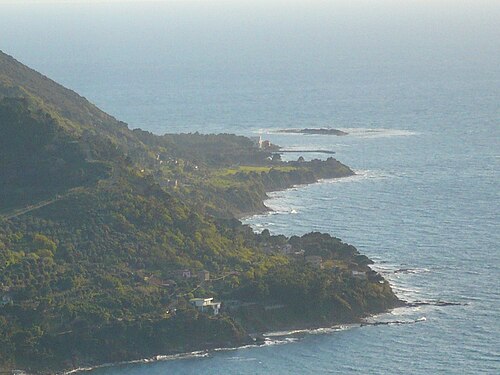Licosa | |
|---|---|
 View of the promontory and the island | |
| Coordinates:40°15′12″N14°54′23″E / 40.25333°N 14.90639°E /40.25333; 14.90639 | |
| Country | Italy |
| Region |  Campania Campania |
| Province | Salerno (SA) |
| Comune | Castellabate |
| Elevation | 20 m (66 ft) |
| Population (2009)[1] | |
• Total | 82 |
| Demonym | Leucosini / Licosani |
| Time zone | UTC+1 (CET) |
| • Summer (DST) | UTC+2 (CEST) |
| Postal code | 84048 |
| Dialing code | (+39) 0974 |


Licosa is a southernItalian village and hamlet (frazione) ofCastellabate, a municipality in theprovince of Salerno,Campania. As of 2009 its population was of 82.[1]
The toponym derives from theGreek word Λευκωσία (Leukosia, Lefkosía inModern Greek), meaning "white". A legend says thatLeucosia was one of the threemythological sirens met byUlysses in theOdyssey.[2] The toponym is therefore related toNicosia (Greek:Lefkosía,Turkish:Lefkoşa), capital ofCyprus, and toNicosia, a town inSicily.
The area, inhabited since theUpper Paleolithic, was settled byOenotrians,Lucani (Leukànoi),Greeks andRomans; as witnessed by the ruins of the ancient Greek city of Leucosia, or Leukothèa. In 846 it was the site ofa naval battle between theSaracens and theDuchy of Naples with allies.[3]
The medieval fief of Licosa, established by the abbotConstabilis in 1123, was part of thebaronage ofCastello dell'Abate, and was administered by the abbots ofLa Trinità della Cava.
Licosa is located in northernCilento, by theTyrrhenian Coast, in a rural area and forest topped by Mount Licosa (326 m). The village, composed of 3 sections named Licosa I, Licosa II and Licosa III,[4] lies nearby a cape namedPunta Licosa.[5] In front of the cape, that counts a little harbor, is located theIsola Licosa (Licosa Island),[6] an islet that hosts a lighthouse.
The village, located betweenSan Marco (3 km north) andOgliastro Marina (4 km south), is 6 km far fromSanta Maria, 7 fromCastellabate, 8 fromCase del Conte, 19 fromAgropoli and 73 fromSalerno.
Licosa's territory belongs to theNational Park of Cilento and its coastline, characterized by theflysch rocks, is part of themarine protected area ofSanta Maria di Castellabate.[7] The territory, far from urban settlements, is surrounded bymaquis shrubland (macchia) and forest.
 Media related toLicosa at Wikimedia Commons
Media related toLicosa at Wikimedia Commons